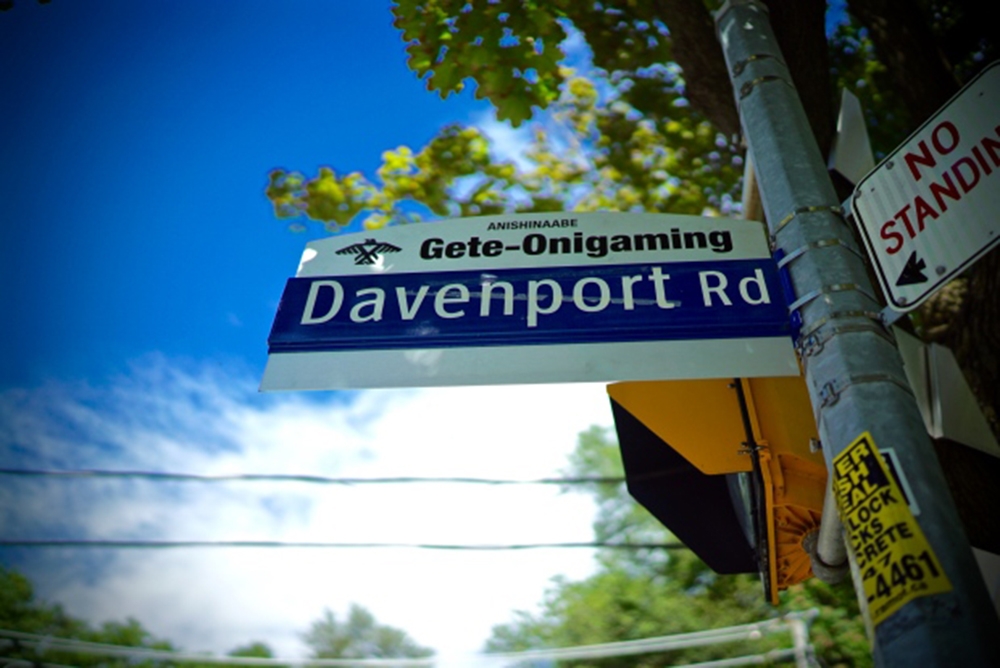Jodie Vanderslot | Contributor
Featured image: The Ogimaa Mikana Project’s efforts to raise awareness have been awarded with sanctioned street renaming. | Courtesy of Craig Chivers of CBC
Canada’s history with Indigenous peoples is often spoken about in hushed tones. In recent years, public apologies like the Truth and Reconciliation commission and movements like Idle No More have shed light on the issues Indigenous peoples face. Apologies aside, some members of the community are taking matters into their own hands.
For three years, the Ogimaa Mikana Project postered around Toronto in an attempt to combat the erasure of Indigenous space by changing street names and reminding non-Indigenous people that this land is Indigenous territory. The group regularly conducts extensive historical research, relying on community members and archeological data to produce accurate translations. Their first initiative was renaming Queen Street to Ogimaa Mikana, which translates to “leader’s trail.” This later became the name of the project.
The project was founded in 2013 by Hayden King, director of the Centre for Indigenous Governance at Ryerson, and Susan Blight, student life coordinator at U of T’s First Nations House, to open a dialogue about the Toronto landscape and its lack of visible Aboriginal ties.
“I want people to think about how renaming is used as a tool of colonial erasure,” said Blight in an interview with The Huffington Post. “It’s an actual erasure of our history and a way of alienating Indigenous people from our own places.”
The project attempts to make the city’s Indigenous history and residents more visible through the use of strategically edited billboards, street signs and plaques. In Queen’s Park, the group posted a short poem on an existing plaque, reminding passers-by that the land is originally native territory; a billboard placed in Barrie proclaims in the Anishinaabe language: “Don’t be shy to speak Anishinaabemowin when it is time.”
However, none of these changes were officially sanctioned until September 15 of this year. You can now see four major streets in Toronto that bear signs with their Indigenous Anishinaabe names: Spadina Avenue has been renamed to Ishpadinaa, a section of Queen Street to Ogimaa Mikana, College Street at Bathurst Street to Gikinoo‘amaagegaming and Davenport Road to Gete-Onigaming.
“This addition to Toronto’s landscape is a wonderful tribute to Indigenous communities and persons and their languages who still live here,” says Professor David McNab, Métis historian and claims advisor for the Nin.Da.Waab.Jig. centre in Walpole Island of the Bkejwanong First Nations. He adds that these changes should be spread across the Greater Toronto Area, including the York campuses.
“I think the addition [of the original Indigenous names of streets] is wonderful—I think it is a tiny component but a significant component. We have to acknowledge that we have a city built on the territory of First Nation peoples. The more we remember clearly about our history on the land, the more we can move to a place of good relation with each other,” states Professor Celia Haig-Brown, who specializes in Indigenous education and critical ethnography.
The Ogimaa Mikana Project parallels the even-larger Idle No More movement. This movement is one of the largest Indigenous movements in Canada, grounded in gaining sovereignty and protecting Indigenous communities from harmful environmental policies. The incitement of this movement unearths another issue: the growing list of unfulfilled promises at the hands of the Canadian government.
“There is progress evident at York. We do have an official statement recognizing the land York University is built [on]. This recognition is being used in all official events and that recognition has been a long time coming, and so making that acknowledgement this year is significant,” says Haig-Brown.
Toronto derives its name from tkaronto, a Mohawk word to describe where Lake Simcoe meets Lake Couchiching, meaning “where there are trees standing in the water.” The Ogimaa Mikana Project urges us to remember Canada’s history and recognize that we are only borrowing this land. It has never been ours to possess, and we have to remember how we acquired it in the first place. Throughout Canada’s history, we cannot say that we have exemplified equity or care when it comes to the treatment of Indigenous peoples. We may have adapted and changed the names, but the Indigenous peoples are still here and face many issues that must be addressed, including access to clean water, food and other basic necessities. Our relationship with Indigenous peoples has been one-sided for far too long; it should work to the mutual benefit of all involved. The Ogimaa Mikana Project is a step in the right direction in working toward a more balanced relationship with the Indigenous community.


